 The habit of whitening sun helmets is a bit like getting shoes polished. The only difference is that shoe polish preserves the leather and prolongs its life, whereas any white substance on a sun helmet can only have visual and reflective reasons. For a military and civilian environment alike, that may have been sufficient reason why it was done. And how? I tried it myself – the blanco’ing of a sun helmet.
The habit of whitening sun helmets is a bit like getting shoes polished. The only difference is that shoe polish preserves the leather and prolongs its life, whereas any white substance on a sun helmet can only have visual and reflective reasons. For a military and civilian environment alike, that may have been sufficient reason why it was done. And how? I tried it myself – the blanco’ing of a sun helmet.
Should one really “paint” an antique? As long as I have been collecting sun helmets, I never regarded the fact that a certain helmet has been whitened by its former owner as a fault or a shortage – when it was done decades ago or whenever the helmet was still in service. The same applied to stains. Each helmet has its history and that has left more or less marks. So why change an antique, witness to whatever known or more often unknown history? I never intended to do so – partly in respect for history, partly, because I had no idea what substance to use and how.
Then I got into possession of a cake of Pickering´s Blanco. According to the box it is to be used for “white sport shoes and boots, cricket pads… military equipment and HELMETS.” By the way perhaps I have only been searching in the wrong places, but somehow this stuff seems to be a rare collectors’ item.
In parallel, I purchased the above sun helmet, marked “* Best English Manufacture * Waterproof Tropical Helmet *.” Though terribly stained, I liked this in particular because of its uncommon shape. Instead of having a plainly oval brim, this example is rounded at the front but has a bit like two sharp corners at the back side – not unlike the naval four seam Wolseley helmet – through, I am very sure, this model has no military background. Unfortunately it looked as if it had spent part of its life – I estimate that to have been somewhere in the 1920s to 1940s – in an oily and greasy workshop. I decided to try blanco´ing this example.
For all questions concerning the history and producers of substances that were used to give pieces of equipment a new color, may it be white, khaki or any kind of green I do recommend http://www.blancoandbull.com/. Here I found practical advice and many hints. Then I started to whiten my helmet.
I followed the instructions as found on the back of the Blanco box: “Brush off all loose dirt. Rub a wet sponge over the cleaner until a creamy liquid is obtained. Apply this evenly, rubbing in well and allow to dry.” First, I brushed the helmet carefully – dry, of course. A cloud of dust appeared – it is astonishing how much dust is hidden in the structure of the cotton – even if it looks clean apart from the stains which stayed. Then I started to apply the liquid, using a paint brush instead of a sponge.
This picture shows the helmet whilst drying. In this phase, when partly wet and partly looking like a cake covered with white powder sugar, I was in doubt, if ever something like an even white surface would come out. But it worked. The fabric of the pugaree is far less dense than the cover of the helmet itself – probably some kind of elastic aertex. Naturally, this part absorbed much more of the “creamy liquid.” The application had to be repeated several times. As well, additional liquid was carefully filled into the gaps of the puggaree, where one layer of fabric is laying on the next. I looked at other whitened helmets in my collection and am sure this was the usual practice, for otherwise it does not look smart but, rather, improperly done.
Note the detail of the pugaree – as mentioned, there is no gap left. This puggaree was still very closely set – if it is not, it is advisable to straighten it – maybe by using additional pins where the folds are. Otherwise the liquid may produce wrinkles. Not to be seen on the picture, but onto the slim white part under the brim, liquid was applied with a smaller brush carefully avoiding the green liner.
In my opinion, the result is quite satisfactory. Despite the one spot on the front side which was treated several times and got smaller, but which appeared again and again. I felt reminded of Oscar Wilde´s “Canterbury Ghost.” I suppose – as mentioned above – that this spot indeed contains grease that repels the liquid to some degree. That has to be considered if whitening is intended. By the way: After my wife watched me for the most part of a Saturday in my study working with Blanco, she asked “Are you going to whiten all of them now?”
Beside the experiment, one more detail might be of general interest concerning military sun helmets. I made a count: 15 per cent of all my sun helmets have been treated with some white substance at some stage of their life by their former owners. These helmets comprise military and civilian examples alike. But, and this is important to note for the reader who wants to try the experiment described in this article, they are all cork helmets, none of them is produced out of pith. See Peter Suciu´s article on the different fabrics used for what became “pith” helmet in the common language.
Now, the experiment described is quite a wet thing. Even if only carefully used, water may destroy the firmness of a helmet made of pith instead of cork. See Rudyard Kipling´s short story The Arrest of Lieutenant Golightly, first published in 1886: A young officer, well dressed up to the latest fashion, is surprised by a monsoon rainfall, turns into a dirt-clad something that is not recognizable anymore and finally arrested. Kipling gives a detailed account of the impact of heavy rain on a pith helmet:
“At the end of another miserable half-hour, Golightly found the world disappear before his eyes in clammy pulp. The rain had turned the pith of his huge and snowy solah-topee into an evil-smelling dough, and it had closed on his head like a half-opened mushroom. Also the green lining was beginning to run.” Even in less drastic circumstances, the effect of water on pith helmets was well known. Now a real pith helmet would probably not survive even a Blanco wet-treatment.
Thinking about this, it came to my mind, that I have never seen a whitened pith helmet. Thinking farther, I know of only one example of a pith helmet that was originally – from its producer – covered with white cotton. Most use khaki or olive drab, even grayish colored fabrics. White ones might have been produced but must have turned out uneconomic – they could not be whitened and, once stained, would not have been worn together with plain clothes any more – neither military nor civilian. When the Solar Topi – a pith helmet – was introduced to the British army in India to replace the Wolseley cork helmet in 1938, it came in a comparatively dark, olive drab color. Was that to keep it wearable as long as possible? I would like to know the readers opinion on this and if anybody does have a snow white Cawnpore Tent Club Helmet or Bombay Bowler please let us all see it!
Roland Gruschka


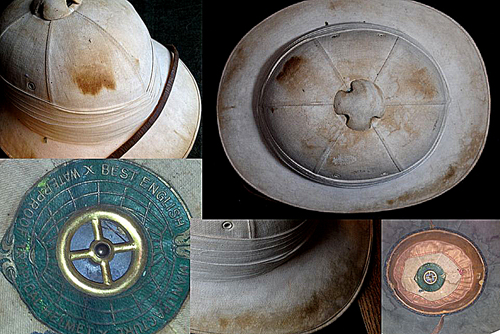
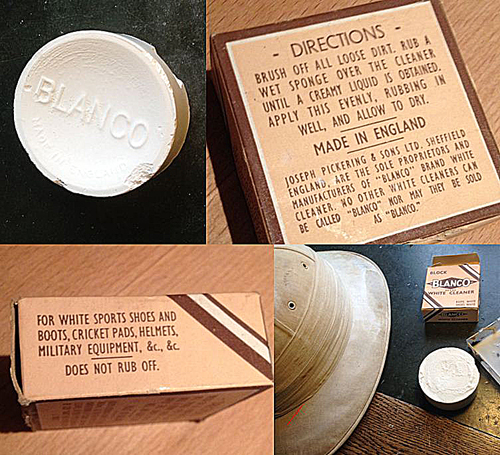
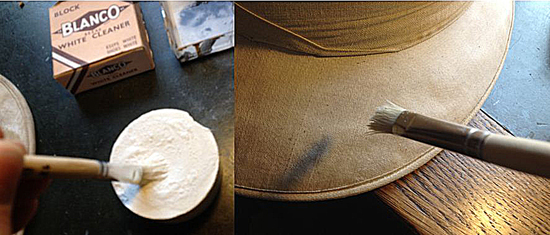
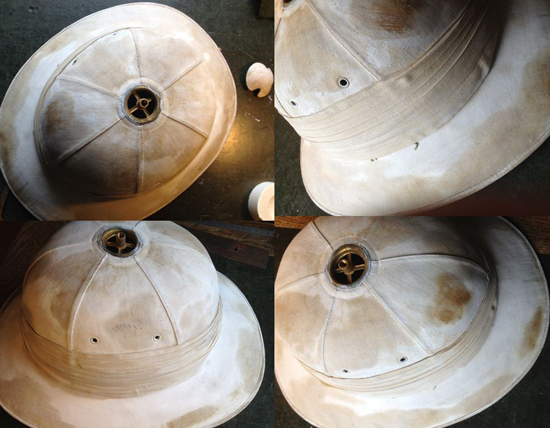
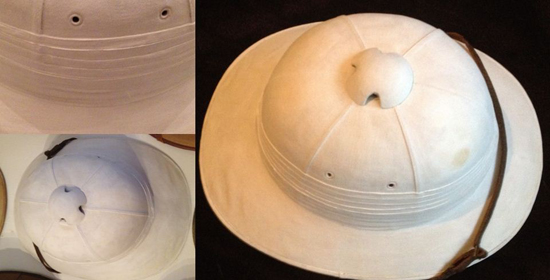
Hello I have original R.Z.Bloomfield ltd london pith helmet .One has been used and the other is new in original brown paper wrap .I put up photos on face book in Australian Military Antique collectors .
Regards Allan
Great article! I just purchased an old Royal Navy pith helmet that I would like to whiten, but I have the same moral conundrum about defacing history. Using an original blanco block makes it feel less like destroying the item so I will have to find a period block to use (doesn’t sound like it will be easy from you article)!
In regards to your question about keeping the Solar Topi smart, I think I have an answer for you. All army Topis I have seen, not civilian or private purchase, have a drawstring cord around the base of the khaki drill cover. Untying this string, and sliding off the puggaree, allows the cover to be removed from the shola pith body. I imagine this allowed the covers to be laundered or replaced as needed. I actually purchased one of these Topis with a smashed crown a few years back and was able to repair the underlying shola pith by taking off the cover and applying paper/Elmer’s glue (I wish I had taken pictures at the time).
l have a few sun Helmets a couple of Wolseleys one from around 1920 and the other is the pressed felt ww2 type also one Bombay Bowler l am have re blancoed all three over the years using liquid Blanco from a supplier in Wales, These come in White, Sand or a colour which is sold as Malta stone all three colours give a superb finish and the last two are very close to the original Khaki often seen. l use a small sponge dabbing in layers until the Helmet has an even coat waiting for drying time before applying the second or even third coat as to the small area of material used as edging on the rim l apply this with an artist paint brush takes time but you do not get any running on to the inside of the Helmet, l suggest if anybody should want to use this method they do the inside rim first leaving the Helmet upside down until dry supported between two old towels so there is no weight on the crown.
What Price Glory sells original (post-WWII) Indian Blanco for cheap ($2 USD), in white and light khaki colors. http://onlinemilitaria.net/products/4535-Blanco